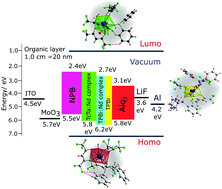Bright neodymium complexes for efficient near infra-red organic light emitting diodes†
Abstract
This paper reports the synthesis, structures, photophysics and optoelectronics of three NIR-emitting ternary neodymium tris β-diketonate complexes, [Nd(hfpd)3(L)n=1–2(H2O)x=0–2](H2O)y=0–1 (hfpd = anionic form of 1,1,1,5,5,5-hexafluoropentane-2,4-dione; L = diphenyl sulfoxide (dpso), n = 1, x = 2, y = 1 (1); L = dibenzyl sulfoxide (dbso), n = 1, x = 1, y = 0 (2); L = triphenyl phosphine oxide (tppo), n = 2, x = 0, y = 0 (3)). The complexes were used as active components in emitting layers to fabricate NIR-OLEDs with multilayered structures: ITO/MoO3 (2 nm)/β-NPB (30 nm)/TcTa:[Nd-complex] (20 nm)/TPBi:[Nd-complex] (10 nm)/TPBi (10 nm)/Alq3 (40 nm)/LiF (0.1 nm)/Al (100 nm). The performance of the present devices is on a par with the best Nd complex based devices reported so far.



 Please wait while we load your content...
Please wait while we load your content...